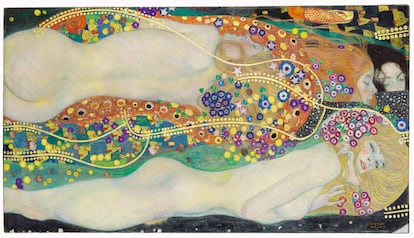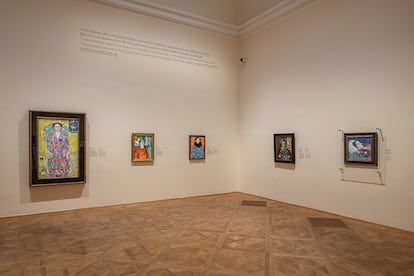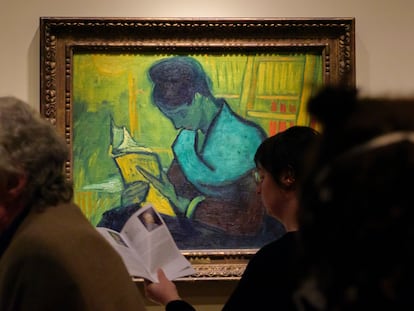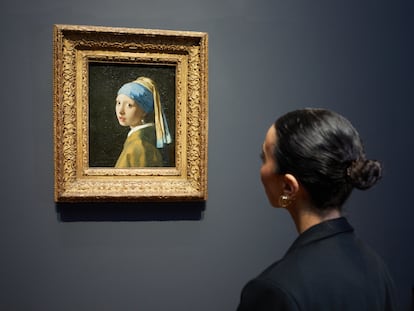Klimt’s most valuable painting stars in a dazzling exhibition at Vienna’s Belvedere Museum
‘Water Serpents II’ survived Nazi looting and ended up in the hands of an anonymous owner

The opening date was approaching, and the museum wall that would showcase the exhibition’s star piece was still bare. The curatorial teams of the Van Gogh Museum in Amsterdam and the Belvedere Museum in Vienna had been working for seven years on a new interpretation of Gustav Klimt. They borrowed pieces by Rodin, Matisse and Cézanne to juxtapose with the Austrian artist’s significant works, but his most highly valued painting – Water Serpents II – was missing. The cost of insuring the piece far exceeded the liability limit for public institutions set by law. At the last minute, an agreement was reached: the anonymous owner would pay the six-figure insurance premium, and the Belvedere would restore the painting in exchange.
Water Serpents II has a tumultuous past. It was stolen by the Nazis from a Jewish textile entrepreneur named Jenny Steiner, a patron of Klimt and other members of the Vienna Secession art movement. It was on the auction block in 1940, but the Reich governor in Vienna, Baldur von Schirach, instead gave it to Nazi filmmaker Gustav Ucicky, Klimt’s illegitimate son, who hung it in his dining room. In 2013, Ucicky and Steiner’s heirs signed a restitution agreement and equally split the $112 million proceeds from its sale. The art market machinery began grinding, and the piece was quickly resold to a Russian oligarch for more than $180 million. He turned around and sold it again for a similar amount. Klimt painted Water Serpents II sometime between 1904 and 1907, but the piece barely saw the light of day. The last time it was on public display in Austria was in 1964.
In mid-January, the painting was delivered to the Belvedere Museum’s restoration workshop, a high-ceilinged studio in the former palace stables. The workshop smells strongly of varnish and solvent and is punctuated with tall monstera plants. The restoration team lead, Stefanie Jahn, and eight other experts took just two weeks to assess the damage and repair tiny hairline cracks on the painting surface. “The canvas is in an enviable condition,” says Jahn, who describes with entomological detail the exquisite finishing touches in Klimt’s paintings.

Jahn’s assessment is welcome news considering that the canvas has survived the demise of the Austro-Hungarian Empire, two World Wars, a civil war and Nazi Aryanization and looting. It has now been expertly restored by the museum with the world’s best Klimt collection, which includes The Kiss.
Jahn personally designed a large, cyclops-like X-ray machine for scanning canvasses. The scan of Water Serpents II revealed Klimt’s initial sketches on the canvas and his various changes to the painting’s nymphs, water serpents and golden vines (which some art historians interpret as a depiction of lesbian eroticism). Klimt painted with precious metals, thin sheets of gold, silver and platinum. “See these brown fish here?” Jahn points to a reproduction of the painting and several images taken through a microscope. “They were originally silver in color and have oxidized over the years, which cannot be corrected.” In an inadvertent reference to the exhibition theme, Jahn adds, “He experimented with techniques and materials used by other international artists of his time.”
Klimt. Inspired by Van Gogh, Rodin, Matisse... first opened in Amsterdam in the fall of 2022. The exhibition had a different name but also spotlighted Water Serpents II. The current show will run through May 29 at the Belvedere Museum to celebrate its 300th anniversary as an art space. The Amsterdam and Vienna exhibitions differ in several ways. In Vienna, Water Serpents I and Water Serpents II are displayed together, but Water Serpents I did not appear in Amsterdam for conservation reasons. Both venues juxtaposed Klimt’s works with Macdonald Mackintosh, the only woman among the 30 artists on display.
The Belvedere Museum assembled more than 90 pieces to dispel the myth of the solitary genius dressed in a blue robe who painted in a garden surrounded by naked muses (including model Maria Učická). The collection brilliantly presents the broad assortment of influences on Klimt. “Our research discovered a very different Klimt,” says curator Markus Fellinger. “Using a series of meaningful comparisons, we illustrate how he assimilated the artistic achievements of his time.” Klimt was a sponge. When he co-founded the Vienna Secession art movement (closely related to Art Nouveau) in 1897, he broke from the traditional artistic styles of the time and became a magnet for avant-garde creators. The Vienna establishment initially ignored the movement, but the city became modernity’s center of gravity. In 1903, for the first time in the Austro-Hungarian Empire, the Secession displayed a Van Gogh painting in an exhibition visited by 16,000 people. Klimt, Paul Cézanne, Pierre Bonnard and Toulouse-Lautrec soon rose out of obscurity to widespread acclaim.

These illustrious artists are all featured prominently in the Belvedere exhibition and present splendidly contrasting styles and themes. Still, it’s astonishing to see the similarities between Klimt’s and Van Gogh’s landscapes or between Klimt’s golden period and symbolist artists like Fernand Khnopff and Franz von Stuck. Klimt’s drawings of female nudes are juxtaposed with Rodin’s sculptures. Other works are placed next to subversive poster art by Pierre Bonnard and Toulouse-Lautrec and paintings by Matisse, Monet, Manet, and Alma-Tadema – the list goes on.
In the last room of the museum hangs the painting Summer Night by the Beach, by Edvard Munch, also exhibited by the Vienna Secession in 1904. Next to it is The Bride, the imposing work that Klimt left unfinished on the easel in 1918 when he died at 55 of pneumonia during the Spanish flu pandemic.
Sign up for our weekly newsletter to get more English-language news coverage from EL PAÍS USA Edition
Tu suscripción se está usando en otro dispositivo
¿Quieres añadir otro usuario a tu suscripción?
Si continúas leyendo en este dispositivo, no se podrá leer en el otro.
FlechaTu suscripción se está usando en otro dispositivo y solo puedes acceder a EL PAÍS desde un dispositivo a la vez.
Si quieres compartir tu cuenta, cambia tu suscripción a la modalidad Premium, así podrás añadir otro usuario. Cada uno accederá con su propia cuenta de email, lo que os permitirá personalizar vuestra experiencia en EL PAÍS.
¿Tienes una suscripción de empresa? Accede aquí para contratar más cuentas.
En el caso de no saber quién está usando tu cuenta, te recomendamos cambiar tu contraseña aquí.
Si decides continuar compartiendo tu cuenta, este mensaje se mostrará en tu dispositivo y en el de la otra persona que está usando tu cuenta de forma indefinida, afectando a tu experiencia de lectura. Puedes consultar aquí los términos y condiciones de la suscripción digital.
More information
Archived In
Últimas noticias
Welcome to the post-religion era: The idea of Christianity as the absolute truth has become obsolete
‘I thought you would like it’: The risky sexual practice popularized by TV shows and TikTok
The digitalization of tourism: ‘They promise experiences and gave us the worst possible one’
Mexican peso defies uncertainty with forecasts of a new period of stability in 2026
Most viewed
- Sinaloa Cartel war is taking its toll on Los Chapitos
- Oona Chaplin: ‘I told James Cameron that I was living in a treehouse and starting a permaculture project with a friend’
- Reinhard Genzel, Nobel laureate in physics: ‘One-minute videos will never give you the truth’
- Why the price of coffee has skyrocketed: from Brazilian plantations to specialty coffee houses
- Silver prices are going crazy: This is what’s fueling the rally











































